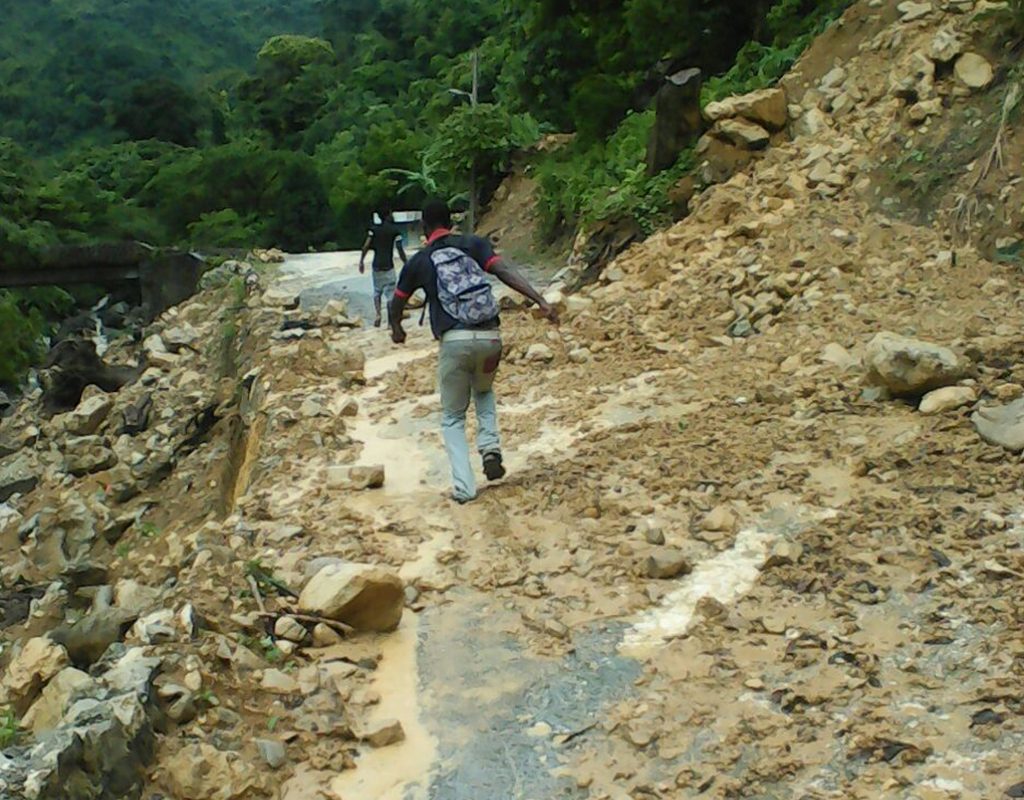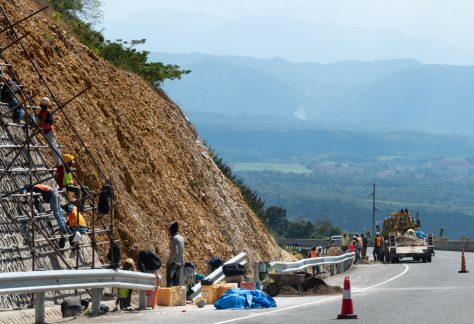Landslides
What is a Landslide?
Landslides are the most common natural hazard in Jamaica. Nevertheless, when natural disasters are mentioned, most people think about earthquakes, hurricanes or flooding rather than landslides. Even the historic records seem to indicate that landslides are less important than earthquakes, hurricanes or floods. In fact, they are often overlooked and forgotten because they frequently coincide with other disasters by which they are often triggered. Port Royal, for example, was almost wiped off the map when a major landslide triggered by the 1692 earthquake took a large part of the town below sea level.
Most people tend to regard landslides as accidents, as something that only happens to others because, in comparison with earthquakes, hurricanes, and floods, landslides affect relatively small and sharply delineated areas. Landslides often move so slowly that even the people living in the affected area are not aware of it. They might only notice that from time to time, especially during or shortly after unusually wet periods, cracks develop in the walls of their dwelling. After a while, they fix these cracks and forget about it.

Facts About Landslides
The driving force behind all landslides is gravity. A landslide will occur when the gravitational pull increases when weight is added to a rock mass, for example – building on a rock or when the rock becomes saturated with water. The strength of a rock mass may be reduced by weathering, earthquakes, etc.

What causes of Landslides?
Landslides occur for a variety of reasons. They often occur as a result of natural phenomena but human activity can also be a factor:
- Vibrations from earthquakes can trigger a landslide.
- Waterlogging due to heavy rains can saturate the top layers of unstable soil and cause them to slide downhill.
- Human activity such as deforestation, vegetation removal, construction of roads, and construction of buildings on steep slopes may also lead to land slippage.
- Landslides may move very slowly from a few centimeters per year to a sudden, total collapse or avalanche.
- Landslides may travel just a few meters to many kilometers in the event of mudflows.
- Landslides can be deadly. They destroy houses, cars, water mains, gas pipes (anything in their path.)
- Landslides and mudflows can strike without warning, trapping or burying people.
Tell-Tale Signs of an Impending Landslide

- Doors or windows stick or jam for the first time.
- New cracks appear in plaster, tile, brick, or foundations.
- Outside walls, walks, or stairs begin pulling away from the building.
- Slowly developing, widening cracks appear on the ground or on paved areas such as streets and driveways.
- Underground utility lines break.
- Bulging ground appears at the base of a slope.
- Groundwater seeps to the surface in new locations.
- Fences, retaining walls, utility poles, or trees tilt or move.
- You hear a faint, rumbling sound that increases in volume in one specific direction and may begin shifting in that direction under your feet.
Protect Yourself from Landslides
How to tell if Your Property or Your Area is at Risk of Landslides
Look at the slopes around you. If the land is soft and steep, if vegetation has been removed, if water collects near a slope, if the slope has been cut into – all of these things could indicate danger. Additionally, if it has happened there before, it is likely to happen again.
Talk to “old-timers,” persons who’ve lived in the area for some time, and ask the experts to find out more about the landslide history of the area. The more you know, the better prepared your area.

What You Can Do About It
Take some of the following action to reduce your risk and loss. This is called mitigation:
- If you have not yet constructed, find out the history of the area and determine whether you really ought to construct there.
- If you go ahead with construction, plant trees and shrubs that bind the soil on slopes and build retaining walls. In mudflow areas, build channels or deflection walls to direct the flow around buildings. There may be legal issues if you divert mudflow to your neighbor’s property.
- Plant or maintain well-rooted vegetation on slopes above and below your property. Don’t remove any trees or vegetation – unless the trees are diseased and pose a hazard.
- Refrain from doing so much paving that you channel storm run-off to where it will collect and saturate the soil.
- Maintain good drainage.
- Beware of building on steep slopes or cutting into them to level the ground for building. It must be done properly and, in some places, not at all. Always consult an expert in this regard.
- Putting too much weight on vulnerable areas can contribute to landslide hazards. So can vibrations, such as those caused by jackhammers or heavy trucks.
- Beware of changing the natural course of water-ways. This can cause problems, if not to you, then to others.
The forces of nature are beyond our control but if we reduce our vulnerability landslides do not have to

